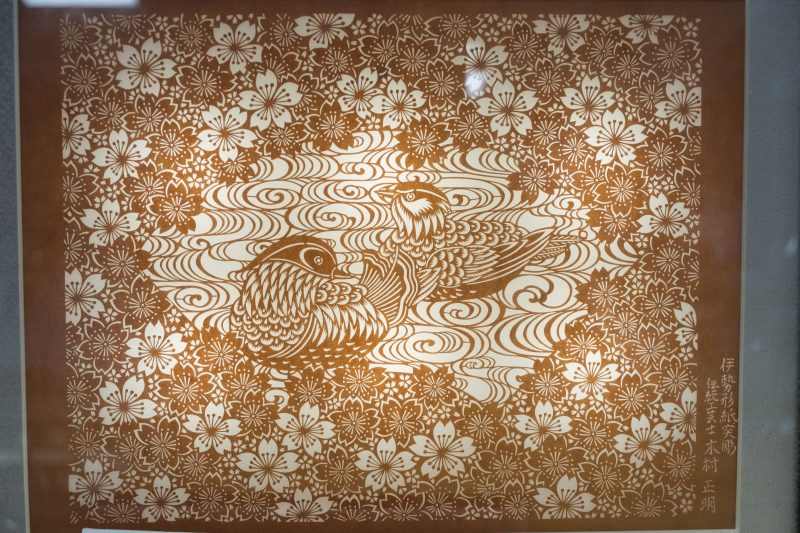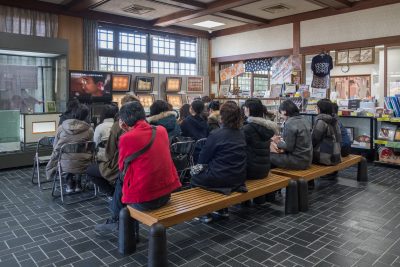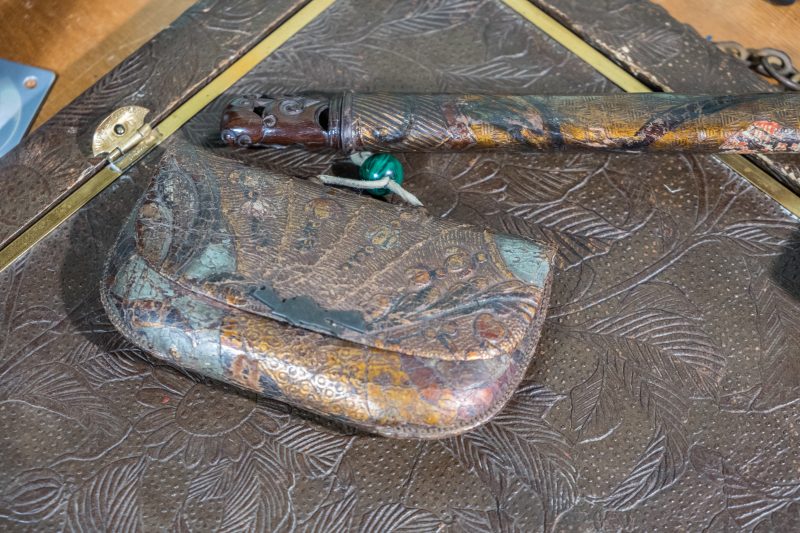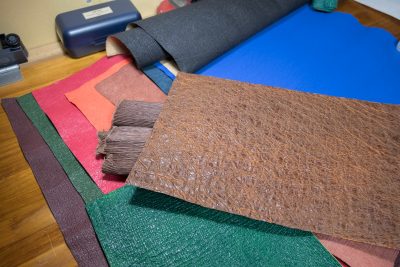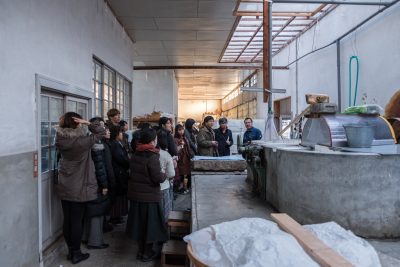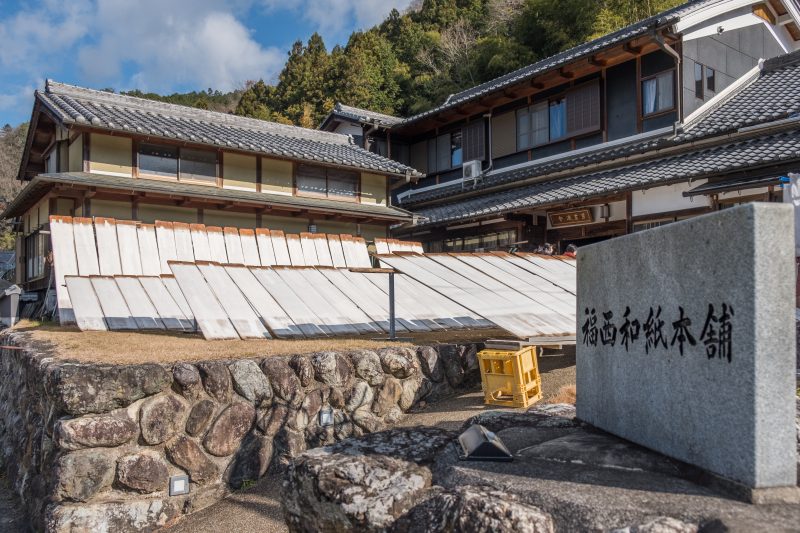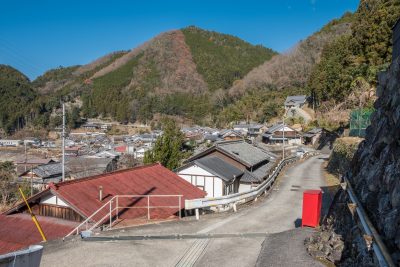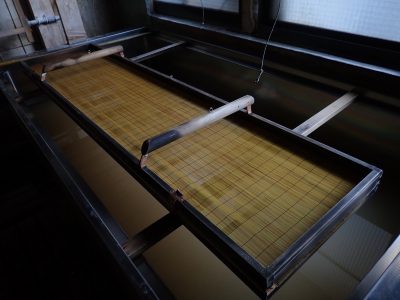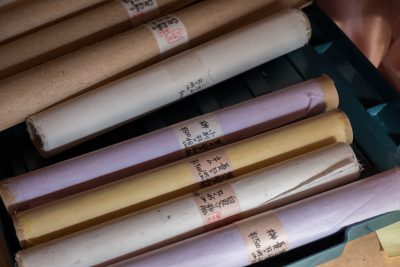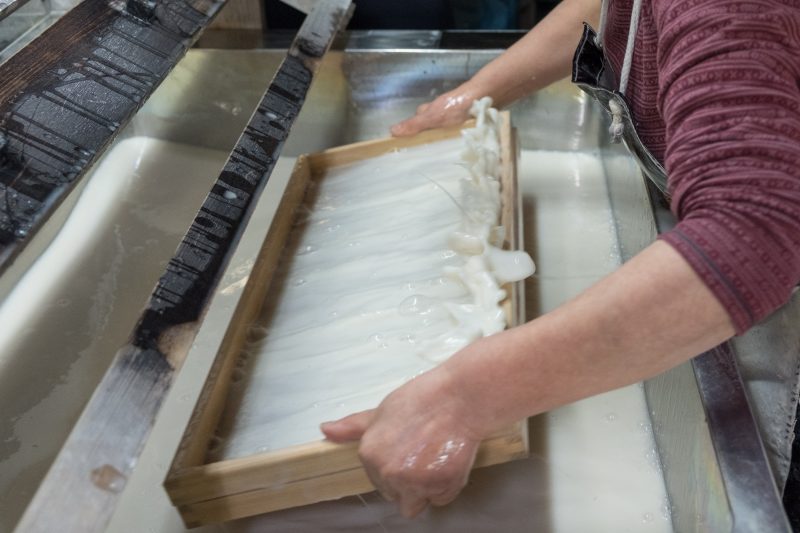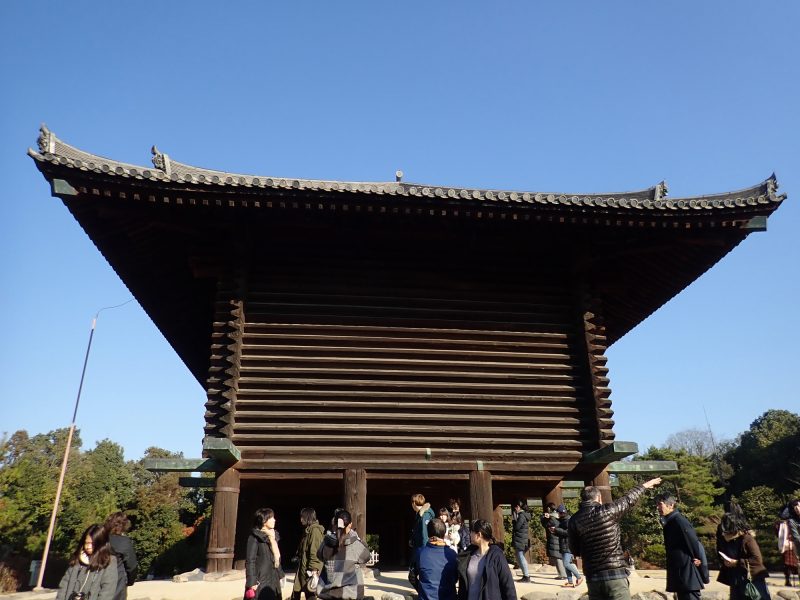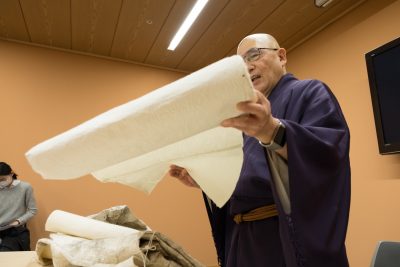和紙旅行2017年12月 伊勢型紙・擬革紙・伊勢和紙・三栖紙・宇陀紙・正倉院・二月堂お水取り
和紙旅行2017のまとめ。
Summary of Japanese paper travel 2017.
2017年度の和紙旅行は、三重、奈良を中心に、伊勢型紙・擬革紙・伊勢和紙・三栖紙・宇陀紙・正倉院・二月堂お水取りなどの紙を巡った。
[参加者]岡田郁代、カクゲイシュ、王尚鵬、張エイハン、劉飛 、李昭墨、浅沼香織、キュウカンギョク、周 業欣、望月 遥、武穂波、岩田明子、齋藤晴香、チェ ユンジョン、内藤 瑠里、秋本知花、河合友理、鈴木美賀子、佐藤友泰、本田光子、冨樫朗、木下幸子、浅田泰子、田中厚美、新関陽香、石故晴菜、磯谷明子、森川美紀
For the 2017 fiscal year, the Japanese paper traveled around Mie, Nara, around the paper such as Ise Katagami, Imitation leather paper, Ise Japanese paper, Misu paper, Uda paper, Shosoin, Nigatus-do water-drawing festival.
[Participants] Ikuyo Okada, Kakugeishu, Wang Shao Peng, Zhang Aihan, Liu Fei, Li Shui, Asauma Kaori, Kyu Kang Gyuk, Zhou Xinxin, Haruki Mochizuki, Miho Mochizuki, Akiko Mutake, Akiko Ichida, Haruka Saito, Ru Li Saito, Kurumoto Akimoto , Tomonari Kawai, Mikako Suzuki, Yoshiyasu Sato, Yoshiko Honda, Akiko Honda, Yuko Kinoshita, Yasuko Kinoshita, Yasuko Asada, Yumi Tanaka, Yoka Tanaka, Haruka Ishidani, Akiko Isoya, Miki Morikawa
【12月20日】【December 20】
1,伊勢型紙 鈴鹿市伝統産業会館 本田様
1, Ise Katagami Suzuka City Traditional Industries Museum Mr.Honda
鈴鹿市伝統産業会館を見学し、伊勢型紙について学んだ。
伊勢型紙の地紙、型紙原紙は美濃紙に柿渋をつけ3枚または2枚の原紙貼り合わせて作る。柿渋を塗り紙を重ね、板で天日乾し、包丁でこそげ、燻しによる枯らしの工程を繰り返し原紙ができあがる。型紙ができるまでおよそ1ヵ月半かかる。実際に使うには1年以上経ったものが良いとされている。
伊勢型紙は、江戸時代に大名が藩独自の小紋を定め、気品の高さを競いあったことから発展した。その後、江戸庶民の間でも小紋柄が流行し、全国的に型紙が浸透した。当時から、紀州藩の特産品として保護受けてきた。
型紙の彫刻は、始めに1)型紙原紙のゴミを取り除く、2)おり引きといって、菜種油を軽く型紙に染み込ませる、3)柄移し:型紙に柄を写し取り、星見つけが行うなど。
伊勢型紙には4つの伝統的な彫り方がある
1)しま彫り、直線を連続的に掘る技法。同じ線を3度切らなければならない。正しい線幅で定規を入れる正確な技術が必要。補強の色糸を入れる必要がある。昔は糸入れと言う技法を使っていたが現在は紗貼りという方法が使われる。(対象の頃から円)紗張りは掘る技術と同じように大変重要な工程である。
2)錐彫が小紋を掘る技法。刃先が半円形をした彫刻刀を回転させながら掘っていく技法。
3)道具彫り刃先自体に模様がある技法。道具を自分で作るこの技法。刃先が違う彫刻刀を駆使する。
4)突彫りは、友禅家へ垂直につくようにして模様を掘る技法。自由な文様が彫れる。
We visited Suzuka City Traditional Industries Museum and learned about Ise Katagami
The base paper of Ise Katagami, paperboard base paper is made by pasting 3 or 2 sheets of base paper with persimmon tannin on Mino paper. Recoating the paper with the persimmon tannin, dry it with a plate, scoop with a kitchen knife and repeat the process of withering by smoking the base paper. It takes about a month and a half to get the Katagami. It is said that one that passed more than one year is good for actually using it.
In the Edo Period, Daimyo established the unique crest of the clan and developed from competing for the height of elegance. Subsequently, even among the Edo people, the small pattern was popular, and the pattern penetrated nationwide. From that time, it received protection as a special product of the Kishu clan.
In the sculpture of the Katagami, 1) remove the garbage of the paperboard base paper, 2) lightly pour the rapeseed oil into the paper pattern, 3) transfer the pattern, copy the pattern to the Katagami, find a star and so on.
There are four inherited carving techniques in Ise Katagami.
1) Technique of digging streaks and digging straight lines continuously. I have to cut the same line three times. Accurate technique to put the ruler with the correct line width is necessary. It is necessary to put reinforcing color threads. In the past I used the technique called threading but now the method called glue paste is used. (Yen from target) Saber is like a very important process like digging technology.
2) A technique for digging kompresses by a cone carving. Technique of digging while rotating a sculpture blade whose cutting edge has a semicircle shape.
3) Tool engraving Technique with a pattern on the cutting edge itself. This technique of making tools myself. We make use of sculptural knife with different cutting edge.
4) Technique of digging a pattern by sticking to the Yuzen family vertically. Free patterns can be carved.
【写真】現代の伊勢型紙作品 【Photo】 Contemporary Ise katagami work
【写真】現代の伊勢型紙の数々 【Photo】 Many of contemporary Ise katagami
【写真】鈴鹿市伝統産業会館 [Photo] Suzuka City Traditional Industry Center
2,松阪・紀勢界隈まちかど博物館:三忠
2, Matsusaka · Kisei town science museum: Sanchu
擬革紙 堀木樣 Gikakushi (Fake leather paper) Mr.Horiki
1684年 、この地は、お伊勢参りの伊勢街道であり、江戸からお伊勢さんまでの最後の宿場町。そこでの販売品として、人気があった事から擬革紙が普及した。当時は、タバコが普及し始めたこともあり、またオランダの壁紙として使われていた金唐革(きんからかわ)に憧れた時期でもあった。日本には革の材料自体が少なく、和紙に注目し、金唐革風のタバコ入れなどを作った事がきっかけである。もともと油紙を使い込んだ状態が革に似ていたことから始まったと言われている。タバコ入れ、敷物、などの商品が開発され、その後海外に目を向け、壁紙や鏡の裏貼り、家具へ応用された。製造技術が途絶えていたものを、和紙の持つ風合いの良さを活かしつつ復活させ、三重県指定伝統工芸品として認定も得ている。
In 1684, this place is the Ise road of the Ise Jingu pilgrimage, the last station town from Edo to Ise. As a selling item there, Gikakushi (Fake leather paper) became widespread due to its popularity. Back then, there were times when cigarettes began to spread, and it was also a time when we longed for Kinkarakawa (Gilded leather), which was used as a wallpaper of the Netherlands. Because there are few materials of leather itself in Japan, it became an opportunity to focus on Japanese paper and make a Kinkarakawa style cigarette case etc. It is said that it started from the fact that the condition that used the oil paper originally resembled leather. Products such as cigarette case and rugs, etc. were developed, then they turned their eyes to overseas, applied to wallpaper, mirror backing and furnitures. They have revived what they were discontinued in manufacturing while making good use of the texture of Washi, and are also accredited as Mie Prefecture Designated Traditional Crafts.
【写真】昔の金唐革。この独特の風合いを革の材料が少ない日本では、和紙で実現する。【Photo】 Kinkarakawa (Gilded leather) of old days. In Japan with few leather materials, this unique texture is realized with Japanese paper.

【写真】当時と同じ質感を目指して、研究を重ねている。[Photo] Doing research aiming at the same texture as at that time.
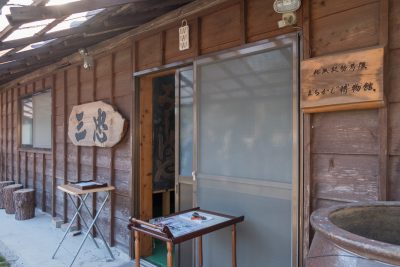
【写真】現在、完全な質の復活を目指す擬革紙【Photo】 Currently, they are aiming for full quality revival of Gikakushi.
3,大豊和紙
3, Taiho washi
中北喜得様、中北喜亮(よしあき)様 Mr. Yoshie Nakagita, Yoshiaki Nakagita
伊勢和紙として、伊勢神宮のお札の紙を中心に漉いている。
1899年、元々、伊勢神宮のお札を作るための会社創業であった。百数十年で、和紙の世界では新参者。大量に紙を生産する為、原料は、全国様々な場所から取り入れている。昔は、手漉きの舟が工場全体にあったが、1960年代から人員不足のため機械化も取り入れ、手漉きは徐々に減り現在は2名で行っている。
見学した日は、雁皮のインクジェット用紙を漉いていた。紙を漉いて、簀の上に水を打つ。簀の上にメッシュも挽くので、さらに簀を濯いで次の紙を漉く。メッシュはナイロン。石川の池田さんから買っている。最近は、なかなか雁皮が手に入らない。二層紙、伊勢和紙の特徴であるインクジョット紙に使用する。コンクリートにタイル貼りの漉き舟である。
原料は土佐の白、三叉は日本産と中国産。原料の産地には、特にこだわっていない。どこの国でも良いものを判別し使用する。それでも伊勢神宮に持っていくと日本産と外国産であれば向こうは日本産を選択される。ここでは、機械漉きはパルプなども使用する。針葉樹パルプ、Nパルプ、土佐の城氷の大判。
奈良学園登美ヶ丘キャンパスで使った大判の漉き舟もある。簀は、竹簀に紗をかけて紙を漉いている。向かい合って2人で漉く。ナイロンメッシュを使用。伊勢和紙では手漉きの最大の大きさが四八判。
干し板は、ステンレス。鏡面仕上げではない特殊な加工。プレスはジャッキでプレスをしている。干し板は天井からワイヤーフックをかけて吊している。紙漉は2人がかりで行う。最低20枚から注文を受ける。
インクジェット紙芭蕉は、土佐楮と化学粘材と芭蕉(マニラ麻)を配合したもの。事業を始めて、2000年くらいから、本格的にインクジェットの需要が出てきた。滲み、画像の精彩さの特性。発色特性、墨と紙が出会って発色している表現性を追求してきた。
Mainly they are making Ise washi for Ise Jingu amulet.
In 1899, it was originally founded as a company to make Ise Jingu amulet. A hundred and several decades, they were a newcomer in the Japanese washi maker. In order to produce a large amount of paper, raw materials are taken from various places throughout the country. In the past, a hand-made boat was in the whole factory, but since the 1960s, mechanization was also taken due to lack of personnel, the handmade gradually decreased and now it is done by two people.
On the day we visited, they were making inkjet paper of Ganpi. Scooping the paper and pour the water above a special sieve-like tool. They also grind the mesh on top of the sieve, further rinse it and then scooping the next paper. The mesh is made of nylon. They are buying it from Mr. Ikeda in Ishikawa. Recently, it is hard to get ganpi. It is used for inkjet paper which is the feature of two-layer paper and Ise Washi. It is a tiled boat of on concrete.
The raw material is white of Tosa, mitsumata is Japanese and Chinese. We are not particularly concerned with the raw material production area. We choose and use good ones in any country. Still, if they take it to Ise Shrine,it is domestic product or foreign, domestic one will be selected. In here, pulp and the like are also used for the mechanical filtering. Coniferous pulp, N pulp, Tosa castle ice large format.
There is also a large-scale boat used at Nara Gakuen Tomiigaoka campus. Putting on gauze on the bamboo sieve and is making paper. Two people face each other and scooping up paper. Using nylon mesh. In Ise Washi, the maximum size of handmade is the 48th rule.
A drying plate is stainless. Special processing not mirror finish. The press is pressing on a jack. The drying plate is hung with a wire hook from the ceiling. The paper making is done by two people. Accept orders from minimum 20 sheets.
Inkjet paper Basho is a mixture of Tosa Kozo, chemical cement and Basho (Manila hemp). Beginning with the project, Demand for inkjet started full-scale since around 2000. Feathering, a special quality of the fineness of the image.They have pursued color development characteristics, expressiveness that inks and paper meet and develop color.
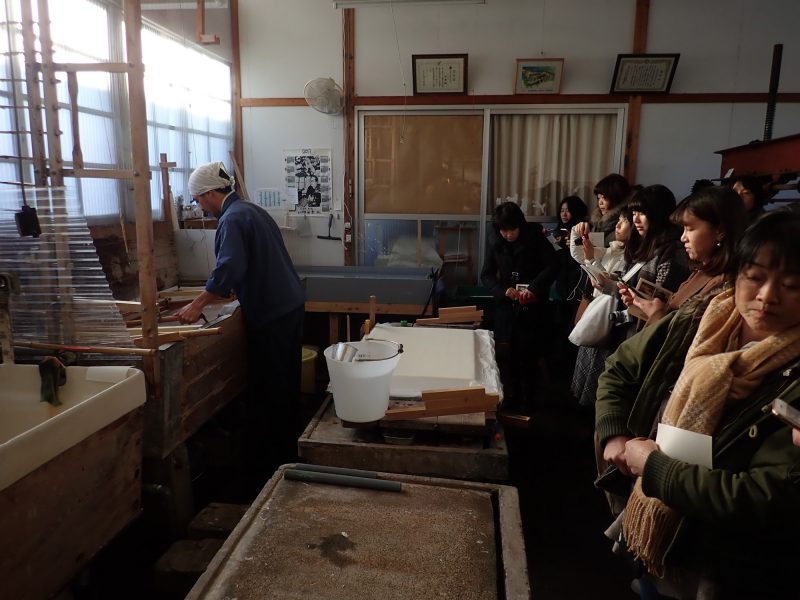
【写真】原料の楮 【Photo】 Raw materials
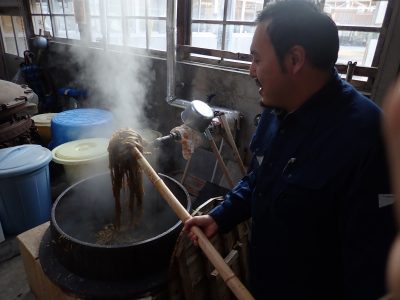
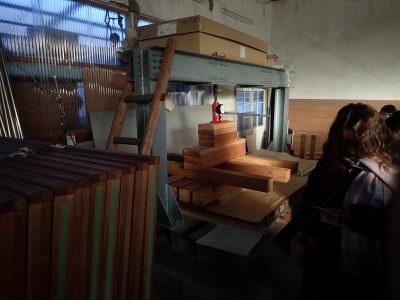
【写真】雁皮の手漉き紙 【Photo】 Handmade paper of ganpi.
【12月21日】 【December 21】
4,福西和紙本舗 福西正行様
4, Fukunishi Washi Honpo Mr. Masayuki Fukunishi
修復用の宇陀紙を漉いている。紙漉には寒い時期が最も適している。修復の紙は6月から9月はいくら言われても制作しない。水は山の水で軟水を使っている。夏場は吉野の杉、檜を使った紙などを作ったりしている。正行さんで6代目。原料は吉野楮。
楮の栽培は、夏の暑い時に手を入れれば良いものが取れる。吉野の風土で育った楮を使うことにこだわりを持っている。原料は、買った方が効率は良いが、原料のことがわかると言う点で、楮栽培は重要と思っている。1.2m程度に切って。蒸籠状の道具蒸す。1月中旬位。春先まで乾燥させて、その後黒い皮を取り吉野の川に晒す。その次にさらに傷取りを行うが、これに3日ほどかかる。ソーダ灰で約1時間半炊く。重要な紙の場合は木灰煮とする。
現在も手打ち叩解を行う。手打ちだと叩解に12時間かかる。楮は叩けばたたくほど、原料に粘りが出て強い紙になる。この効果は使い手に、出来上がった和紙の毛羽立ちがなくなると言ってもらえる。
白土を混ぜて漉くのが吉野の紙の特徴。山に白土固まりで取りに行って、中国産の石と混ぜ攪拌する装置に36時間位かけ、液状になったものを天日で乾かして白土を採取する。
簀は今では珍しい萱簀。吉野紙は竹簀だと土が乗ってこない。薄い紙は細かい簀、厚い紙は太い簀を使う。萱簀を作る人が現在2人ぐらいいるけど、なかなか今は発注してもできてこない。
紙を漉いて、積み上げて一昼夜置く。長い方が良い。
粘材は一般的にはトロロアオイを使うが私たちはノリウツギを使う。樹皮の部分を叩き潰してネリとして使う。今までは北海道の契約先から仕入れていたが、鹿の被害でノリウツギが取れなくなり、自分で北海道に昨年行き、三日間走り回ってやっと自ら使う分を確保した。
ノリウツギは冷水が合う。薄い紙は寒い時期に漉きたい。お彼岸からお彼岸までが紙漉の時期。秋の彼岸からせいぜい5月いっぱいまで。(夏場は精神的にも気持ちが焦る)冬場の方が落ち着いて仕事ができる。紙漉は、ほとんど家内工業。紙漉は量産を取るか、質を取るかに分かれていった。こだわって質を取るなら家内工業でしっかりとした仕事をした方が良い。
世界遺産になっている石州、細川、美濃は保存団体がある。吉野はその様な対象ではないが、ボストン美術館の北斎などの修繕も宇陀紙を使ってもらっている。いろんな美術館や博物館の保存修復に使っていただいており、お互いの信頼関係でいい紙を提供できる。
色宇陀はトマトの茎を煮出して染める。最近は化学染料も多いが天然染料トマトで染める。裏打ち紙としては、世界中で使われている。色宇陀も白土が入っている。薄口、10口、8口がある。ミョウバンで媒染している。その他、草木染めの紙もいろいろやっている。桜、アケビなど。叩いたあと先染めで原料を染める。
1年に1回、夏場に干し板洗いをする。割れ目は和紙を貼って補修する。デンプン糊で貼る。干し板の板貼りは、板を水平に置き、長上を使い、紙を取り上げ、板上に置くようにして紙を置き、その上で刷毛を使って板張りする。
Uda gumi is made for restoration. A cold period is the most suitable for paper making. From June to September, no matter how much demand these papers are, they will not be produced. Water uses mountain soft water. Yoshino cedar and cypress are used during the summer. Mr. Masayuki is sixth-generation. The raw material is Yoshino Kozo.
Cultivation goes well if they take good care of Kozo during the hot summer. They are committed to using Kozo which grew up in Yoshino. It is more efficient to buy raw materials, but in terms of understanding raw materials, They think that cultivation is important. Cut it to about 1.2 m. Steaming tools like a basket. Middle of January. Dry until spring, take a black bark and expose it to the Yoshino River. After that, take scratches but it will take about 3 days. Boil it about an hour and a half with soda ash. For important papers, boil with wood ash.
Currently refining beating hand. It takes 12 hours to refine it if hand-rolled. The more you hit it, the more sticky the raw material it becomes stronger paper. This effect is said to be said to the user that the fuzz of wash paper will be gone.
It is Yoshino ‘s paper’ s characteristics to mix and clay the clay. Go to the mountain to settle on a white ground and take it for about 36 hours in an apparatus that mixes with Chinese stone and stir it, dry it in the sun in liquid form and collect the clay.
The bamboo cake is now unusual. When Yoshino paper is a bamboo fence, the earth does not come. Use thin paper for thin paper, thick paper for thick paper. There are currently around two people who make kayaku, but it is quite difficult to place orders now.
Filter the paper, pile up and put it all day and night. The longer the better.
In general viscous materials use Trollawyeo, but we use Nori Tsugi. Use it as a neri by crushing the part of the bark. Until now I was purchasing from contractors in Hokkaido, but I can not take Nori Tsugi because of the deer damage, I went to Hokkaido last year, I ran around three days and finally secured my own use.
Nori Tsugi is cold water matched. I want to make thin paper in the cold weather. It is a period of paper making from the coast to the shore. From the shore of the autumn to the end of May at most. (Summer is also spiritually frustrated) You can work calmly in winter. Paper strains are mostly domestic industries. The paper maker was divided into whether to take mass production or to take quality. It is better to do a solid job in house industries if you stick with quality and stick.
There are conservation groups in Ishizu, Hosokawa, Mino which are world heritage. Yoshino is not such a subject, but Hokusai’s repair of the Boston Museum of Art is also being repaired by Uda. It is used for preservation restoration of various museums and museums, and it is possible to provide good paper with mutual trust.
Color Uda boils the stem of tomato and dye it. Recently there are many chemical dyes, but can be dyed with natural dye tomato. As backing paper, it is used all over the world. Color Uda also contains clay. Thin mouth, 10 mouths, 8 mouths. Mordanted with alum. In addition, I also do a variety of paper of plant dyeing. Sakura, Akebi etc. After tapping, dye the ingredients with a dye dye.
Once a year, wash the panels in the summer. Repair the crack by pasting Japanese paper. Stick with starch paste. Plate the board in a horizontal position, use the long head, pick up the paper, place the paper on the board, and then use the brush to plate it.
【写真】福西和紙本舗 【Photo】 Fukunishi Japanese paper Honpo
【写真】吉野の街並み 【Photo】 Yoshino’s streets
【写真】宇陀紙の簀桁。現在では、珍しい萱簀。【Photo】 Uda paper gauge. At present it is a rare cedar.
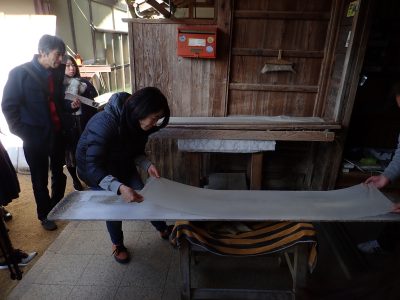
【写真】様々な和紙の種類、草木染め 【Photo】 Various kinds of Japanese paper, plant dyeing
【写真】様々な和紙の種類、杉皮入りなど 【Photo】 Various kinds of Japanese paper, cedar skin etc
5,上窪良二様 美栖紙
5, Mr. Ryuji Kamikura Miyoshi Mi
愛知芸大の保存修復研究所にも美栖紙を納めている。
紙漉と蚕の技を吉野に伝えた。617年、672年に吉野では紙が漉かれていたと言われている。平安中期の延喜式、吉野のこの地域には、最盛期には280件紙漉きがあった。今はもう5軒。福西和紙と漆のゴミを取る、漆濾し紙の昆布さん。
表具の和紙。重要文化財の修復に使われている紙が多い。作り手と使い手との信頼関係によって作り上げられてきた上の文化である。伝統的なことを守って昔ながらのやり方で進めていくことが重要。多少は現代の工夫もしますが。
原料はソーダ灰、または木灰で炊く。荒打ちは機械を使って、後は手作業で行う。叩き込むとしなやか原料になる。紙漉は縦ゆりだけ。その後に漉いたあと、勢いよく直接板に押し付けるように板移しする。
She also pays beautiful paper at the conservation and restoration laboratory of Aichi Geijutsu.
I told Yoshino about the skills of paper mills and silkworms. It is said that in 617 and 672, paper was being strained in Yoshino. There were 280 paper makers in this area of Yoshino in the mid-Heian period, during the peak period. There are already five more now. Konbu of lacquer-filtered paper, taking Fukanishi Japanese paper and lacquer garbage.
Japanese paper of tableware. Many papers are used to restore important cultural properties. It is a culture above that has been built up by the trust relationship between the creator and the user. It is important to keep traditional things and proceed in a traditional way. Although some contemporary contrivance is also done.
Cook raw materials with soda ash, or wood ash. Rough striking is done using machines and later manually. Suppress it and become a supple material. Only paper lily is longitudinal lily. After that, transfer it so that it presses directly against the board with vigor.
【写真】美栖紙を漉くところ 【Photo】 Place Misumi paper
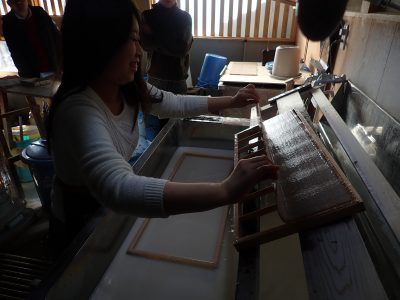
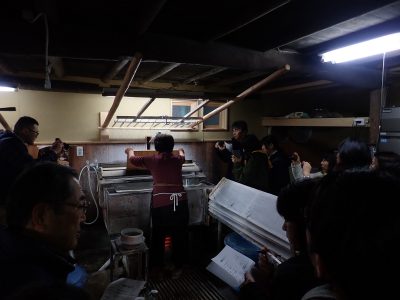

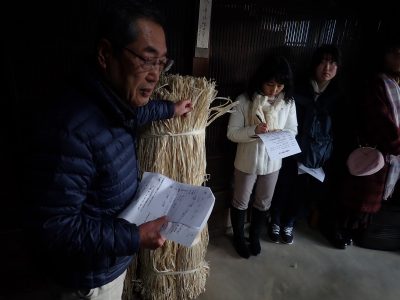
【12月22日】 【December 22】
6,正倉院 正倉院事務所 佐々田様
6, Mr. Sasada, Shosoin shrine temple office
正倉院宝物は、宮内庁の管轄で国の管理。文化庁所管とは違う宝物庫である。秋に勅使(ちょくし)がやってきて全宝物を確認し、天皇の印の宝物の封印を行うまでの2ヶ月が最も忙しい。よって鍵を開ける事自体が困難である。
建物は、昭和35年まで、校倉造の宝物殿に入っていた。まずは、初期的な宝物殿を建て、稼働させ検証し現在の宝物殿を建てた。正倉院は、職員が変わらない。研究員と表具師。
湿度を55から60%に保たなければならない。木工品は温湿度が必要。どうしてもカビが生えるので、注意が必要である。
聖護蔵、中国の随唐の時代。称徳天皇、南北朝時代の紙と墨のもの。敦煌写経とは違うもの遣唐使を通じ入ってきたもの。紙の出来は素晴らしい。写経の事務的な記述を記したもの。写経の裏を事務作業で使った跡がある。
正倉院は、奈良時代から何度か解体したことはあるとみられる。高床式は8世紀前半。コンクリートの土台は大正期に作られた。校木を組んだ構造。校倉造と言われる。鎌倉時代には落雷もあった。1300年が経っているので、木が炭化している。触れることは厳禁。木材はすべてヒノキ。三角形材は、丸太から材を引き出すのに効率の良い形。これまで、泥棒にも入られている。現在は、中には櫃、箱のみ。記録では、修理の後に盗まれる事がおおい。柱には、傷が沢山ある。
まだ、ノコギリが使われていない時代か。引き鋸や引きカンナは無く、糸鋸状のものが合った程度。
北倉には天皇が使っていたもの。東大寺の文物。中国のものや、刀などは、現在からすれば神技的なものもある。南倉は、大仏関連の法要の時使用するもの。8世紀の布、絹など。
中倉が、その他東大寺の役所のもの。そこに正倉院文書があった。写経所。写経の試験、写経の勤務などの記録が残っている。
明治になって延焼を防ぐ為周辺の土地を買って現在の庭園の形になる。
瓦は、平成22から26年に葺き替えた。天平時代の瓦も数百枚あった。使えそうな瓦は再度使用。天平平安、鎌倉、室町、江戸。鬼瓦は天平のものは見つかっていない。
(特別な許可を頂き、入場させて頂いています)
Shosoin ‘s treasure is the administration of the country under the jurisdiction of the Imperial Household Agency. It is a treasure box different from the Agency for Cultural Affairs. In autumn the imperial ordinance came and confirmed all the treasures, the two months until the seal of the emperor’s sign’s treasure are the busiest. Therefore it is difficult to open the key itself.
Buildings were in the treasure shrine of Shimura built until 1965. First of all, I built an initial treasure shrine, started it, verified it and built the current treasure shrine. Shosoin, the staff will not change. Researcher and clerk.
Humidity should be kept at 55 to 60%. Wood products require temperature and humidity. Attention is necessary because mold certainly grows.
Sanjukuro, the era of Tang Dynasty in China. Emperor Emeritus, things of paper and ink of Namikoku Morning era. Different from Dunhuang Shunki Things that came in through Tang Dynasty. The making of paper is wonderful. An administrative description of the transcription. There is a trace of using the back of the sutra in office work.
Shosoin is believed to have been dismantled several times since the Nara era. The high floor type was in the first half of the 8th century. The foundation of concrete was made in the Taisho era. Structure with school trees. It is said to be a scholarly construction. There was also a lightning strike in the Kamakura period. Since 1,300 years have passed, the trees are charred. It is strictly prohibited to touch it. All the timber is hinoki. Triangle material is a form that is efficient in drawing material from logs. It is also a thief so far. Currently, only in the chest, box. In the record, it is often stolen after repairing. There are many scratches on the pillars.
Is not it yet era when saw pile is not used? There are no pulling saws or pulling cannas, and the extent to which saw-like things fit.
Kitagura used what the Emperor used. Culture of Todaiji Temple. Chinese things and swords etc are also technically something from now. Nankikura is used at the time of the Great Buddha related law. Cloth of the 8th century, silk etc.
Nakuraku, other things of the government office of Todaiji. There was a Shosoin document. Shinkansen. There are records such as the examination of the sutra and the work of the sutra.
In the Meiji era to buy surrounding land to prevent spreading fire to become the shape of the current garden.
The roof tiles were changed from Heisei 22 to 26. There were hundreds of roof tiles of the Tempyo era. I used the roof tile that I could use again. Tianpyou Heian, Kamakura, Muromachi, Edo. I can not find anything of Tenpyo from Oniki.
(I received a special permission and I am allowed to enter)
【写真】正倉 南側 [Photo] Shogakura South side
【写真】正倉院文書、コロタイプなどの見学 【Picture】 Visit Shosoin document, colotype etc.
【写真】コロタイプなど説明をされる佐々田様 [Photo] Mr. Sasada, who will explain the corotype etc.
【写真】正倉を近くで見せて頂いた 【Photo】 I showed Shosaka closely
7,東大寺総合文化センター総長 7, President of Todaiji Total Cultural Center
東大寺 筒井寛昭様 Hiroaki Todaiji Tsutsui
752年は大仏様が完成した年。その年からお水取りが始まっている。東大寺として大仏様を祀る仏教行事があるなか、二月堂での行事はもう少し小さい単位で人々の幸せを祈るもの。
3月10日に水を組み上げるためにお水取りという。もともと東大寺としてひとつの行事であったが全体的にそう呼ばれるようになった。3月の1日から14日まで2週間行われる。
南都のお寺は9人の祈願をもとに作られた東大寺、西大寺、唐招提寺は平城京に都が移ってから作られた。興福寺、薬師寺などはもともと明日香にあって平城京に持ってきたお寺である。新しい寺は、高句麗の影響受けている。古いお寺は新羅の影響受けている。
二月堂のお水取りは、寒い時期の行事なので防寒を考えなければならないから紙子というものが使われた。紙子を着ると言うことは神聖な行事であること。
紙子には、木綿の裏地が付いている。お水取りの道具類は、いたるところに紙を使っている。
2週間着たものを見せてもらう。篝火(かがりび)の煤で汚れている。
紙子は、泉貨紙でできている。これまで白石の遠藤さん。愛媛の菊池さん。泉貨紙は、溜め漉きの2層紙。白石の遠藤さんは現在はやめてしまわれた。
その他様々か紙を見せてもらう。白鳳天平時代に書かれた華厳経断簡。下は焼焦げになっている紺紙の紙。百万塔陀羅尼、世界で始めての木版印刷。陀羅尼は法隆寺が有名だが様々な寺にもある。
平安末から鎌倉。神護寺経典だと言われている。表紙が残っているのが中々ない。裏にも装飾がある。まったく変色していないが銀色が、輝きを失っていない。
陀羅尼経。名塩紙に、墨に熊野の熊胆を混ぜ版木で刷る。お水取りの僧侶が少しずつこれを食べる。
(特別な許可を頂き、撮影させて頂いています)
752 years is the year when the Great Buddha was completed. Watering has begun since that year. In the presence of Buddhism events dedicated to the Great Buddha as a Todaiji, the event in February is a little smaller unit praying for people’s happiness.
It is said to take water to build water on March 10. Originally it was a single event as Todaiji, but it came to be called so entirely. It will be held for two weeks from 1st to 14th of March.
The temple in Minami is made based on the prayers of nine people, Todaiji Temple, Saidaiji Temple, Toshodaiji Temple was made after the capital moved to Heijojyo. Kofukuji, Yakushiji are originally located in Asuka and are a temple brought to Heijo Kyo. The new temple is influenced by Goguryeo. The old temple is influenced by Shilla.
Watering in Februo is an event in a cold period, so paper-making has been used since we have to think about cold weather. To say that wearing paper is a sacred event.
Paper has a cotton lining. Instruments for water removal use paper everywhere.
I will show you what I’ve worn for two weeks. It is soiled with soot of firebread.
Paper cartons are made of ten paper. Mr. Endo of Shiraishi until now. Ms. Kikuchi from Ehime. The billboard is a two-layered paper of a sushi stock. Endo of Shiraishi is now stopped.
Have others show me the paper. A decubitus written in Hakuho Tenpyo era. Below is a paper of blue navy which is burnt. Million tower Dalarni, the world’s first woodblock printing. Daranami is famous for Horyuji, but also in various temples.
Kamakura from the end of Heian. It is said that it is a Jingo-ji scripture. There are sometimes a cover left. There is decoration on the back. It is not discolored at all but silver color, it has not lost its shine.
Dalarni sutra. Printing on a salmon paper, Kumano ‘s bear bold mixed with ink and a log. Watering monks eat this little by little.
(I have taken a special permission and I will shoot it)
【写真】東大寺 筒井寛昭様 [Photo] Hiroaki Todaiji Tsutsui

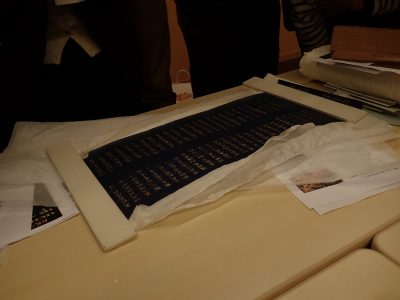
【写真】名塩紙に、墨に熊野の熊胆を混ぜ版木で刷ったもの。[Photo] On a salmon paper, printed with brush mixed with Kumano’s bear in black ink.
